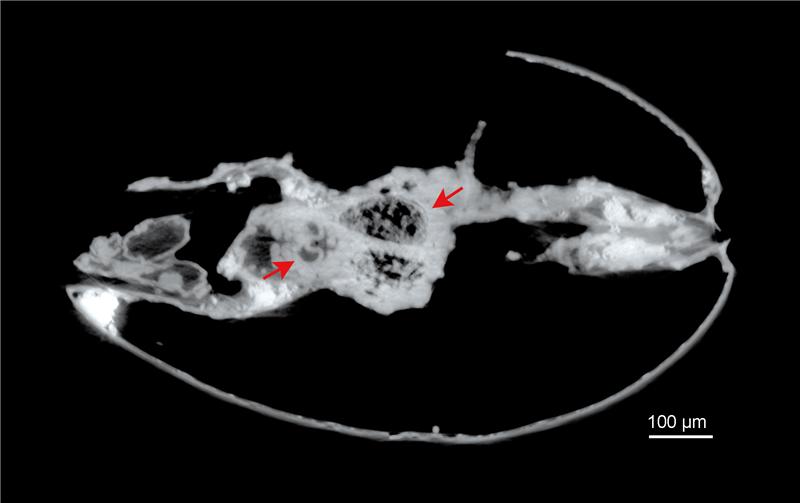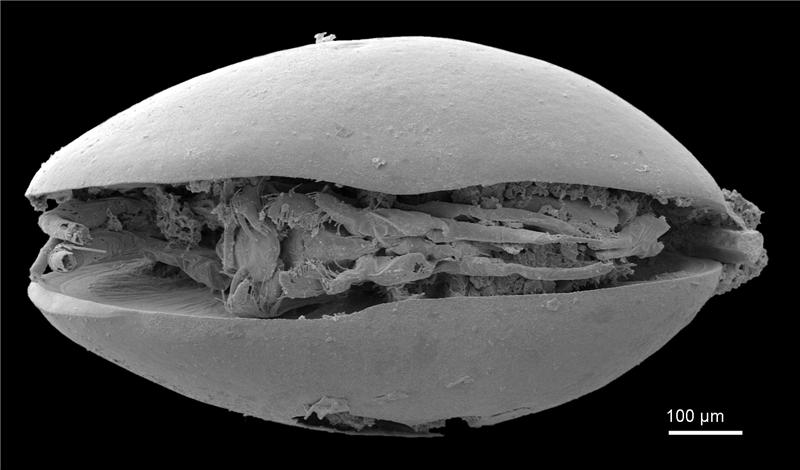The international team analyzed Harbinia micropapillosa specimens from the Cretaceous Period that had remains of the soft body intact. These fossils had been collected, investigated and then donated to the Natural History Museum in 2000 by Robin Smith, now at the Lake Biwa Museum, Japan, a member of the research team. Eight years later, the same specimens were analyzed using synchrotron X-ray holotomography at the European Synchrotron Radiation Facility (ESRF) in Grenoble, through collaboration with Paul Tafforeau, a palaeontologist at the ESRF. This method is currently the most powerful and sensitive way to investigate in three dimensions and at a microscopic scale, the internal anatomy of exceptional fossils without damaging them.

Synchrotron holotomography represents a virtual longitudinal section through the 100 million-year-old fossil ostracod Harbinia micropapillosa. The left arrow shows the preserved inner part of the oesophagus, while the right arrow points to the two seminal receptacles, where this female stored the giant sperm cells after mating. Credit and copyright: R. Matzke-Karasz
Matzke-Karasz said, "In these microfossils, we detected organs that are required for transferring giant spermatozoa. Since modern ostracods still produce giant sperm and manoeuvre them with the same organs as 100 million years ago, it’s safe to say this distinctive feature evolved only once in this group. It seems to be an evolutionarily successful reproduction strategy, even though it comes at an exceedingly high price for both genders, as a lot of energy is invested in producing and carrying such enormous sperm."
“Holotomography is a non-destructive imaging technique like computer tomography (CT), but we use powerful and coherent synchrotron X-rays leading to a sensitivity thousand times higher,” explains Paul Tafforeau of ESRF. “It is since very recently that palaeontologists use this technique to image fossils, but the results achieved so far show that this technique will surely lead to many important discoveries on fossils,” he adds.
The X-ray examination of the fossilized ostracods revealed direct parallels with the complex reproductive apparatus of modern relatives of these Cretaceous fossils. The team also came across something of a surprise: two of the female specimens had inflated cavities that only occur in modern ostracods that have recently mated, meaning fossil evidence for an insemination had been uncovered.

Although the Cretaceous Santana Formation in Brazil is famous for its exceptionally preserved fish, it also yields ostracod fossils with preserved softparts – a very rare occurrence. The species Harbinia micropapillosa, here depicted as a scanning electron micrograph, reveals stunning details of the appendages. Now, a synchrotron holotomographic investigation showed that even internal organs can still be identified. The investigated fossils are housed by the Natural History Museum in London. Copyright:NHM, London.
The team was completed by Radka Symonová, scientist at the Charles University in Prague and Giles Miller, Micropalaeontology Curator at the Natural History Museum.
A human sperm would have to be over 17 meters long in order to measure up against one group of modern ostracods, whose sperm are up to ten times as big as the animals themselves. Roughly 34,000 of the 50 micron-long human sperm would have to line up to match the body length of a man (of 1,70m).
The next stage of the research from the international team is to understand why and how reproduction with giant sperm has persisted for so long.
The research was led by Ludwig-Maximilians-Universität Munich and received funding from the ESRF (Grenoble), the European Union in the scope of the Marie Curie RT Network SEXASEX and the Lake Biwa Museum, Japan.
Additional facts:
• Twenty-one specimens from the Natural History Museum’s micropalaeontology collection were used for the research and five of the specimens showed internal evidence of sexual organs
• The fossils were scanned using holotomography at the European Synchotron Radiation Facility in Grenoble, France, on beamline ID19
• All the holotomographic original and processed data presented in the publication will be made available to the public at the ESRF’s online palaeontology database, http://paleo.esrf.eu
• Modern animals that reproduce with giant sperm include featherwing beetles, several frogs, moths and backswimmer species, ostracods and fruit flies, such as Drosophila bifurca, whose sperm measures around six centimetres while the fly is only a few millimetres in length.






Comments